Routes 1,2,3:
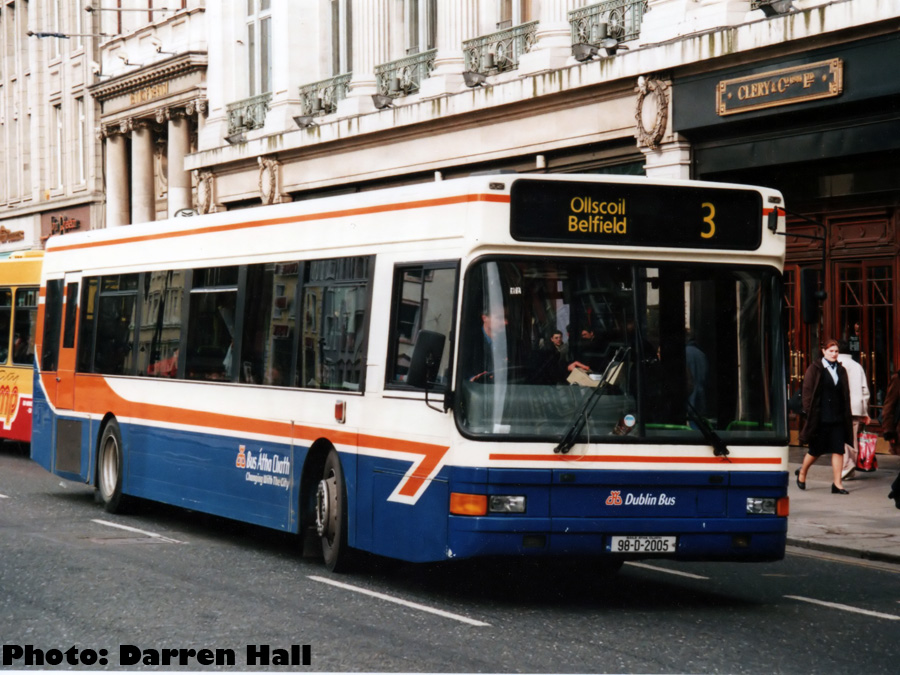
Alexandra Ultra bodied Volvo B10L, VL5, on Route 3 to University College Dublin Belfield seen pulling away from the former 3 stop outside Clery's in O'Connell Street on the 19th March 2001.
The first tram service to Sandymount began in 1872 with horse trams operating via Bath Avenue on what was to become Tram Route 4 and then bus route 52. It wasn't till 1900 that the route via Ringsend began, being electrically operated from its outset. Ringsend, at this time, was a working class maritime area, and therefore was outside the general passenger base of the Dublin United Tramways Company, which was seen to serve only the wealthy areas of Dublin at this point.
The Sandymound via Ringsend tram began operation on the 4th July 1900 between Sandymount and Victoria Bridge (the bridge over the Grand Canal basin). This bridge had to be replaced in order for the line to be completed and hence the Inchicore trams were extended to the other side of Victoria Bridge. This link between Inchicore and Sandymount would reappear in the bus era as Route 52A. The bridge was constructed by Ross and Walpole, North Wall, commencing in 1900. It was a metal swivel bridge, which allowed craft to pass quickly between the Canal Basin and Ringsend Basin. When the bridge was opened the electric supply was interrupted and hence the DUTC had to fit special fittings to ensure the supply of electricity upon closure. This bridge was rebuilt in 1961 and renamed as the MacMahon Bridge, it also being rebuilt in 2006.
When Victoria Bridge opened on the 18th March 1901 the line was connected and trams operated from Sandymount to Nelson’s Pillar, with the following routing:
O'Connell Street (Nelson’s Pillar), O'Connell Bridge, D’olier Street, Great Brunswick Street (renamed Pearse Street in 1920), Ringsend Road, Irishtown Road, Tritonville Road, Sandymount Road, Seafort Avenue (returning Newgrove Avenue), Strand Road, Sandymount Tower.
The Inchicore Route was therefore reduced to operate to Westland Row only. The depot for the Sandymount trams was on Gilford Road, and a branch off the line at Strand Road allowed the electric trams to access the shed built adjoining the old horse tram depot of Route 4.
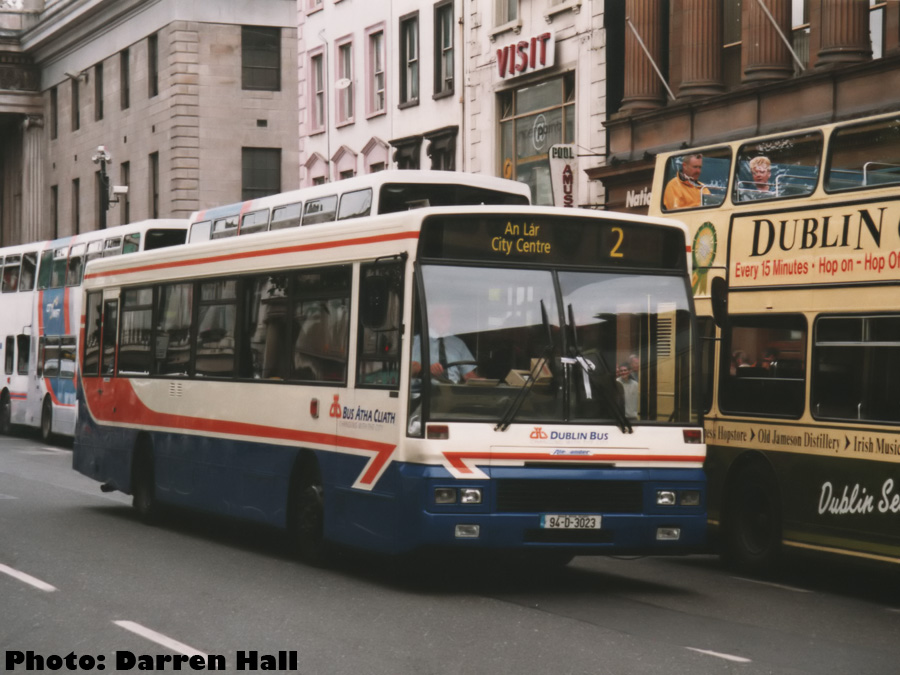
Alexander Setanta Bodied DAF SB220, AD23 heading seen on O'Connell Street on the 24th June 2000 having operated a route 2 journey from Sandymount. AD23 is seen here in fleet livery, but was one of the AD class buses that operated Route 3 in Cityswift livery, minus the Cityswift stickers. The AD class were similar to the P-class, both being DAF SB220, however concerns with the Plaxton body lead Dublinbus to look to Alexander.
The timing for the introduction of this route is interesting in that it corresponds with the opening of the DUTC electrical generating power station on the Ringsend Road, the current location of Ringsend Bus Depot, which opened in August 1899. The Power House supplied all the electricity required for the DUTC network after 1901 when the temporary Ballsbridge and Clontarf generating stations were shut. The Power House still exists today, just outside the bus garage on the west perimeter (photo here). The rest of the site was the Permanent Way yard in which stocks were kept for the upkeep of the tramway network. Its location was optimal; adjoining Grand Canal Docks.
The DUTC were not to develop their Route numbering system till 1918, instead, due to high levels of illiteracy, they used different coloured shapes to distinguish routes. Each tram carried name boards (on the sides, generally just above the bogies indicating the route they were on, i.e. Nelson's Pillar via Ringsend, Sandymount), destination box on both ends, and finally above the destination box was a sign containing a coloured shape. Trams on the Sandymount via Ringsend Route therefore used a board displaying a Green Crescent Moon to signify their route.

Then in 1918 when Route numbering was introduced numbers 1, 2 and 3 were used to signify:
Route 1: Trams from Nelson Pillar to Thomas Street Ringsend, beside where the library is currently located.
Route 2: Trams from Nelson’s Pillar to Sandymount Green.
Route 3: Trams from Nelson’s Pillar to Sandymount Tower.
In 1907 the International Exhibition, also known as the World’s Fair, came to Dublin, held in Herbert Park. The main attractions at World's Fairs are the national pavilions, created by participating countries. In order to celebrate the event and promote the tramway network the DUTC issued a guide to their tramway network compiled by their secretary R.S. Tresilian. His eloquent description of the Sandymount line warrants inclusion in full:
"Nelson's Pillar to Sandymount: Distance 3 miles, cars run every 7½ minutes.
The cars start from Nelson’s Pillar, and pass along the east side of Lower Sackville Street, across O’Connell Bridge, and through D’olier Street to Brunswick-street, into which they turn left, and continuing through its whole length, passing Westland Row on the right, cross the new swing bridge over the Canal Dock into Ringsend-road; the Central Power Station of the Company being on the left, conspicuous by its two very tall chimney shafts, and at which the whole of the electric current required in the working of the system is generated; they pass hence over the Ringsend Bridge (close to the homes of the several Dublin Rowing Clubs) through the essentially fishing village of Ringsend and Irishtown, and Sandymount-road, to Sandymount village, through the Stand Road skirting the shore to the Martello Tower, where they stop."

Van-Hool bodied Leyland Atlantean AN68, D656, is seen on O'Connell Street on the 23rd September 1993 operating a Route 1 departure to Pigeon House. D656 was part of a batch for AN68s (D656-9) that moved from Clontarf to Ringsend in late 1988.
Like its opening the closure of this route occurred in stages. The first to go were Route 3 trams on the 7th February 1938. This involved the removal of the section of track between Gilford Road and Sandymount Tower only as the section between Sandymount Green and Gilford Road was required to access the depot. The shorts to Ringsend were then withdrawn on May 1st 1939, the 2 tram continuing on until March 26th 1940.
The service to the Martello Tower was replaced by Route 52A which was extended from its previous terminus of Sandymount Green to terminate at the Tower. This route had been introduced by the DUTC from the City Centre to Sandymount in 1936. It was then extended towards Inchicore in 1937 to terminate at Ring Street, thus remaking the transportation link between Ringsend and Inchicore first introduced prior to the completion of the Victoria Swing Bridge. This route was curtailed on the 5th February 1940 when the 21 trams to Inchicore were replaced by number 21 buses operating to Ring Street. The Sandymount section lived on between College Street to Sandymount Tower until March 26th 1940 when Routes 2 and 3 buses replaced the trams.
Route 2 buses directly replaced the trams operating the same routing between Nelson's Pillar and Sandymount Green. The 3 however was introduced as a cross city route, operating from Sandymount Tower to Whitehall with the following routing:
Whitehall Roundabout (A roundabout at the junction of Collins Avenue and Swords Road - long since removed; though the angle of the houses at this corner gives the secret away), Swords Road, Drumcondra Road Upper, Drumcondra Road Lower, Dorset Street Lower, North Frederick Street, Parnell Square East, O'Connell Street, D'olier Street, Pearse Street, Ringsend Road, Irishtown Road, Tritonville Road, Sandymount Road, Seafort Avenue (returning Newgrove Avenue), Strand Road, Sandymount Tower (turning on Strand Road).
During the Emergency, shortages of diesel and rubber for tyres lead the DUTC to make a number of adjustments to their bus network. Route 3 was curtailed to operate from Nelson's Pillar to Sandymount Tower only from the 13th March 1942. The reappearance of Whitehall denoted services only occurs in the December 1944 issue of the DUTC bus timetable, and at this point it is only a limited service, peak hour only on Monday-Friday operating on selected journeys between the hours of 0822 and 1842 with a 2hour gap between morning peak and lunch hour services. Saturday was a full service, in that all route 3 buses operated to Whitehall between 0822 and 2149, with just early morning and late night services cut short, while Sunday had no service to Whitehall at all.
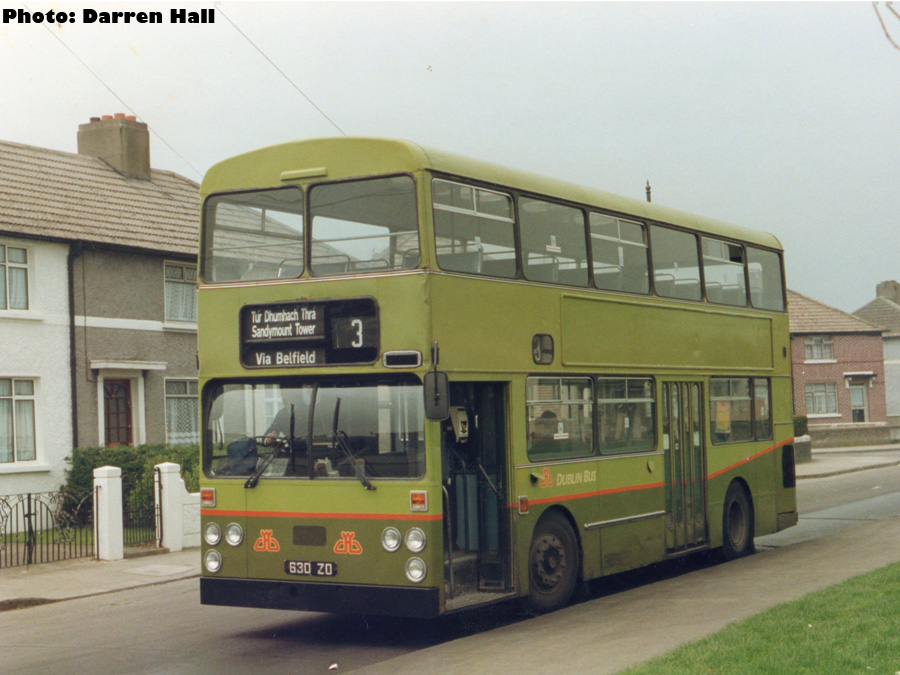
Van-Hool bodied Leyland Atlantean AN68, D630, at the Larkhill Terminus on the Glendun Road on the 9th March 1993. D630 is interesting in that it entered service in February 1977, well over a year after the D629 and D631. The reason for this was that it was built with an experimental all welded body which proved unsuccessful and it was rebodied prior to entering service. D630 was withdrawn during the Sector 4 changes in 1994 when Route 3 was moved out of Ringsend Depot.
Full service would not resume to Whitehall until Route 3’s extension to Larkhill in the second half of 1947 (sometime between August and November). The terminal arrangements were slightly different in that the bus took the first right into Larkhill Road past the school. It also did not originally terminate at the green on the Glendun Road. A small metal church was built for the residents of the surrounding area prior to the completion of Whitehall Church and this was located at this point. The terminus was back from this near the junction of Larkhill Road and Glendun Road.
The route was also extended at this time to its current Sandymount terminus at St. John's Church. The routing was then as follows:
Glendun Road, Larkhill Road, Swords Road, Drumcondra Road Upper, Drumcondra Road Lower, Dorset Street Lower, North Frederick Street, Parnell Square East, O'Connell Street, D’olier Street, Pearse Street, Ringsend Road, Irishtown Road, Tritonville Road, Sandymount Road, Seafort Avenue/Dromod Terrace/Prospect Terrace (returning Newgrove Avenue), Strand Road, St. John's Road East (St. John’s Church).with Route 2 still operating shorts between Nelson's Pillar and Sandymount Green.
Route 1 was reintroduced early in 1951 (sometime between January and May) operating between Nelson’s Pillar and Pigeon House (Generating Station). It was operated mainly for E.S.B. employees and its timetable corresponded to shift changes at the station. The Pigeon House closed in 1976, replaced by the Poolbeg Generating Station, opened in sections between 1971 and 1978. Route 1 operated as follows:
Nelson's Pillar, O'Connell Street, D'olier Street, Pearse Street, Ringsend Road, Bridge Street, Thorncastle Street, Cambridge Road, Pigeon House Road, Power Station.
The Pigeon House power station was opened by Dublin Corporation in 1903 on the site of a former military barracks of the same name. It derived its name from a wooden house which was built early in the eighteenth century near its site. This house was called Pidgeon's House from its occupation by a watchman of the name of Pidgeon. It was a popular location frequented by many boating parties to whom Pidgeon supplied refreshments. So many came that he eventually set up a boat himself for the conveyance of his customers to and from the shore.
The Poolbeg station is itself due for closure in 2010, this time not to be replaced calling questions on the existence therefore of Route 1. The Poolbeg extension site has also recently been in the news due to the purchase of the old bottling plant site for €400 million euro. It had been planned for a large residential and business development to take place on this site however with the recent economic turmoil the land has been drastically reduced in value making the scheme unviable. Poolbeg is also in the news as it is to become the site of a new waste incinerator in Dublin, only 4km from O'Connell Street in the heart of the city.
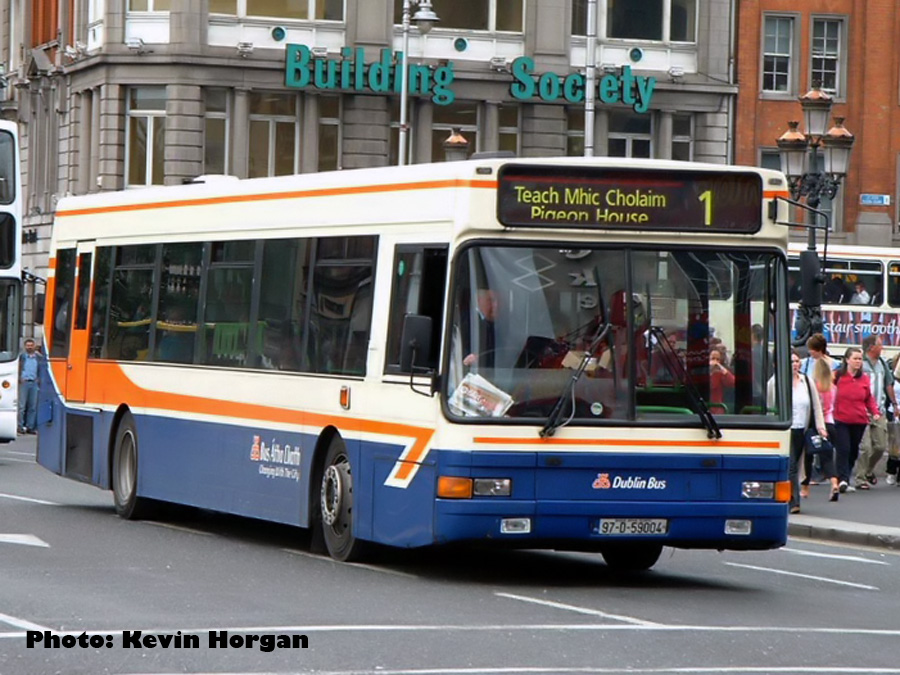
Alexandra Ultra-bodied Volvo B10L, VL4, is seen on O'Connell Bridge operating Route 1's 1708 departure from Parnell Square to Poolbeg Extension on the 16th July 2002. The Ultra-bodied was designed based on the Swedish design produced by Säffle, itself a subsidiary of Volvo. The class proved unsuccessful with Dublin Bus, finally being withdrawn during the May 2009 cutbacks. VL2-5 were the last still in service and have all been bought by Scottish Operator McColls in Dunbarton. VL1 is still in Donnybrook garage, converted to a hospitality unit. It has a rear store room, several tables and power points throughout the bus.
On and from Monday 11th September 1961 Victoria Bridge was closed which required the 2 and 3 to be rerouted until it was reopened. The routings were as follows:
Route 1 and 2: Nelson's Pillar, O'Connell Street, D'olier Street, Pearse Street, Macken Street, Grand Canal Street, Barrow Street, Ringsend Road and as per previous routings.
Route 3: Larkhill as per normal routing to O'Connell Street, D'olier Street, Pearse Street, Westland Row, Fenian Street, Grand Canal Street, Shelbourne Road, Landsdown Road, Newbridge Avenue, Sandymount Road and as per normal routing to St. John's Church.Because of the low bridges on Macken Street and Barrow Street Routes 1 and 2 were operated by Single Deck buses, the first time Ringsend depot operated single-deck vehicles. The 2 and 3 had originally been Double-Deck vehicles from inception, the 3 remaining double deck until the introduction of the AD class in 1994. It is interesting to note that due to recent withdrawals of weekend DART services between Grand Canal Dock and Connolly Stations, Ringsend single-deckers are again operating along Grand Canal Street and Barrow Street under the bridge.
Victoria Bridge re-opened on 1st February 1963 with Routes 1, 2 and 3 returning to their previous routings with the 1 and 2 reverting to Double-Deck operation. The bridge would then be renamed MacMahon as previously indicated above.
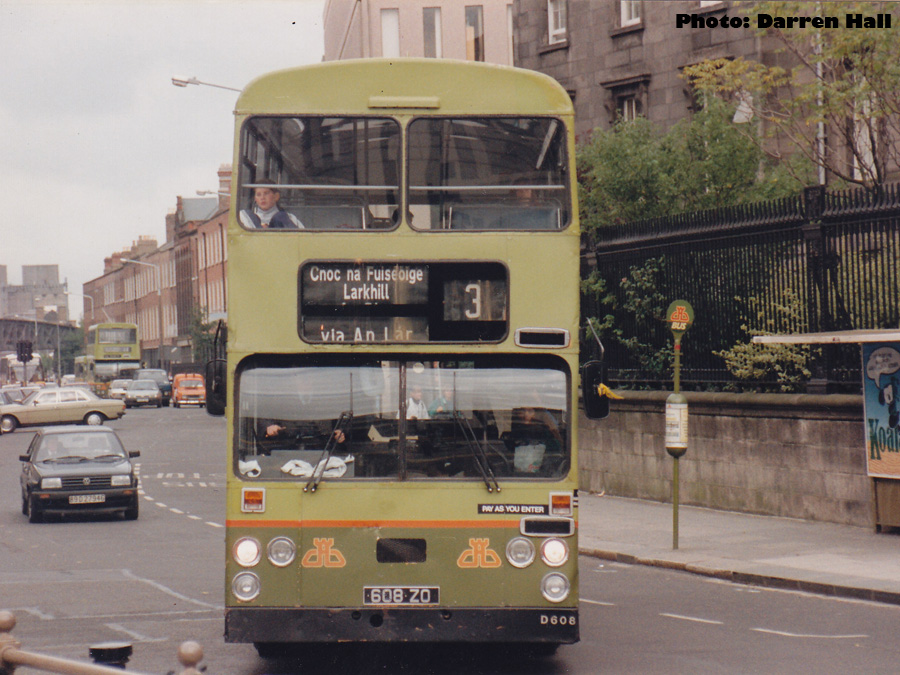
Van Hool bodied Leyland Atlantean AN68, D608, seen here operating Route 3 having just pulled away from its former stop opposite Pearse Street Garda Station, now part of the Lucan Corridor termini. This photograph was taken on the 16th September 1993, a few weeks before D608's withdrawal. D608 had been one of the first batch of Van Hools delivered in late 1974 to Clontarf Garage. It transferred as part of a batch of Van Hools (D608/9/22/3/5-30) sent to Ringsend from Clontarf in early 1991.
On the 18th March 1964 Routes 1 and 2 changed terminus from Nelson’s Pillar to Burgh Quay (Route 52 stop). This was as part of a number of one-way streets introduced by Dublin Corporation on this date. The city centre routing became:
Inbound: Pearse Street, Tara Street, Burgh Quay.
Outbound: Burgh Quay, D’olier Street, Townsend Street, Lombard Street East, Pearse Street.
For Route 3 the city centre routing became:
To Larkhill: Pearse Street, College Street, Westmoreland Street, O’Connell Street, Parnell Square East, North Frederick Street.
To Sandymount: North Frederick Street, Parnell Square East, O’Connell Street, D’olier Street, Townsend Street, Lombard Street East, Pearse Street.
On Wednesday the 16th December 1964 Parnell Square was made one way with the direction of traffic flow as it is now. One way streets had proven to be quite successful and more were added as temporary measures in order to cope with Christmas traffic, though they would never revert to their previous forms. Route 3's city centre northbound routing therefore became:
To Larkhill: Pearse Street, College Street, Westmoreland Street, O’Connell Street, Parnell Street, Parnell Square West, Parnell Square North, North Frederick Street.
At this stage Pearse Street was one way between Westland Row and College Street, the first section between College Street and Tara Street made one way in March 1964 and the section between Westland Row and Tara Street for the Christmas 1964 changes. The final section to be made one way was the section between Westland Row and Sandwith Street on the 18th March 1965. Therefore Routes 1, 2 and 3 continued on Townsend Street to Sandwith Street to access Pearse Street on their Sandymount-bound journeys as per their current arrangement.

RA223, a Alexander RH-bodied Volvo Olympian, seen when brand new operating Route 3 on Parnell Square East to Belfield. RA223 had just recently been delivered and would go on to operate Route 46A after its CitySwift conversion in 1996. Note the conductor in the window. Route 3 was one of few routes at this point that was still operated by conductors in 1995, the vast majority of the rest being one person operated.
On Tuesday, August 16th 1966, the one-way road system was extended to Burgh Quay. The direction of traffic flow was eastbound from O'Connell Bridge to Tara Street. This meant that the whole south quays from Heuston Bridge to Shaw Street was one-way eastbound. The Eden Quay and Burgh Quay services swapped termini, except for the 53s which were moved to Marlborough Street. However, the month of August saw the city bus services being paralyzed by a trade union strike by road workshop staff supported by all busmen from August 8th to 24th. Buses returned on the 25th, and hence the new termini arrangements were in force from this date.
Therefore Route 1 and 2 terminus was changed to Eden Quay, their routing becoming:
Inbound: Pearse Street, Tara Street, Butt Bridge, Eden Quay.
Outbound: Eden Quay, O'Connell Bridge, D'olier Street, Townsend Street, Sandwith Street, Pearse Street.
These terminal arrangements proved unworkable, with both Butt and O'Connell Bridges used by northbound and southbound buses. Therefore on the 25th September 1966 the Eden Quay and Burgh Quay routes reverted back to their previous termini. This involved southbound buses departing from Burgh Quay and using Shaw Street to access Townsend Street. For Routes 1 and 2 this would have meant that the eastern section of Townsend Street would have been the first location that they served with Route 3; which would not have been ideal. Therefore Routes 1 and 2 remained at their terminus on Eden Quay, no doubt helped by the fact that the 53 services remained at their new terminus on Marlborough Street.
The next change to Routes 1 and 2 was in the first half of 1969, sometime between 10th February and 8th June, when their city centre terminus was changed to Parnell Square East, allowing them to serve both the Parnell Square and O'Connell Street stops of Route 3. Routing was as follows:
Inbound: Pearse Street, College Street, Westmoreland Street, O'Connell Street, Parnell Street, Parnell Square West, Parnell Square North, Parnell Square East.
Outbound: Parnell Square East, O'Connell Street, D'olier Street, Townsend Street, Sandwith Street, Pearse Street.
On the 29th October 1969 North Frederick Street was made one way towards O'Connell Street, with Granby Row made one way outbound, to complete the current arrangement. Route 3's North city routing outbound therefore became: O'Connell Street, Parnell Street, Parnell Square West, Granby Row, Dorset Street Upper.
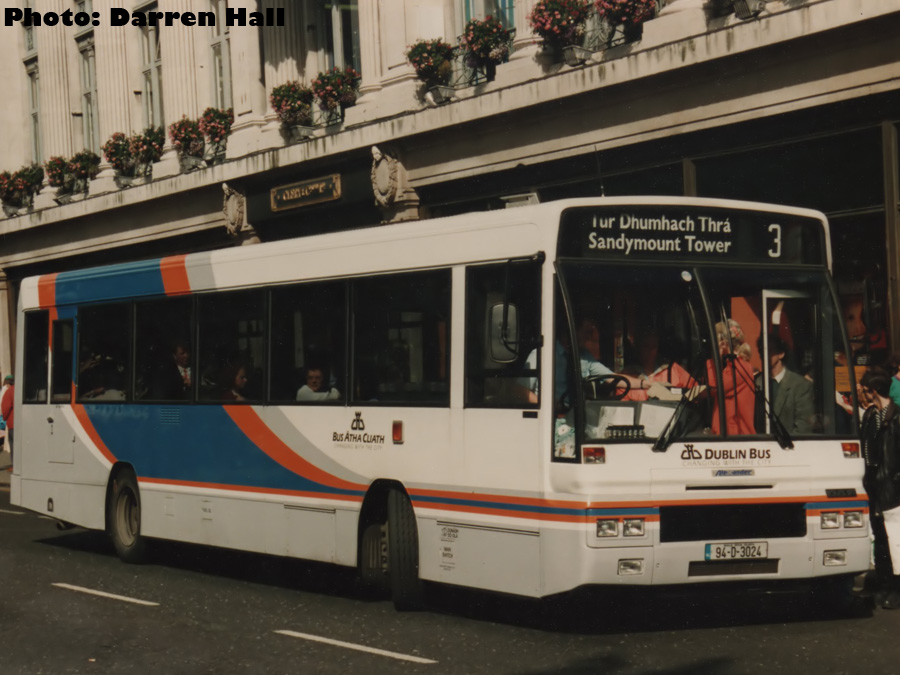
Alexander Setanta-bodied DAF SB220, AD24, seen loading on O'Connell Street on the 3rd September 1994. This was one of a large batch of AD single-deckers that were used on previously double-deck routes. AD24 was part of a batch of buses (AD9,11-34) that would see out their days on Phibsborough routes such as the 40 having been transferred from Donnybrook in Summer 2003. Phibsborough would nearly a year later withdraw AD24 after receiving further AD class buses from Donnybrook, only 10 years after these buses took to the road.
In the mid-to-late 70's the terminus arrangements at Larkhill were changed such that Route 3 took the second right into Larkhill Road, then terminating at Glendun Road as per its current arrangements. This was due to the fact that the previous routing passed the front gate of Larkhill Primary school, the rerouted service thus avoiding this.
The opening of the East Link Bridge in 1984, Ireland's first tolled bridge, caused the routing of the 1 to be ammended slightly. The alignment of the Pigeon House Road which had previously been connected in full was changed to meet with the Sean Moore Road at a new roundabout. The 1 continued straight through the Roundabout, serving South Bank Road and Whitebank Road before rejoining its previous routing on the Pigeon House Road.
The mid-80s saw the introduction of a new electrified railway in Dublin, known as Dublin Area Rapid Transit or DART. Launched in the summer of 1984, it was meant to be part of a complete reorganisation of public transit along the corridor, where principal arterial bus routes running alongside the line would be dropped in favour of high frequency DART feeder services operating from the stations to the surrounding areas.
However this scheme was never fully implemented due to Union disagreement with the plan. In fact the first DART feeder services did not run for over 18 months after the launch of the DART, hence most people had found alternative transit to and from the station. The DART feeder issue got caught up in a wider One Person Operation (OPO) dispute; with CIE trying to force full capacity OPO routes. This would have meant using the KC-class buses to their full capacity and the use of double-deckers as OPO.
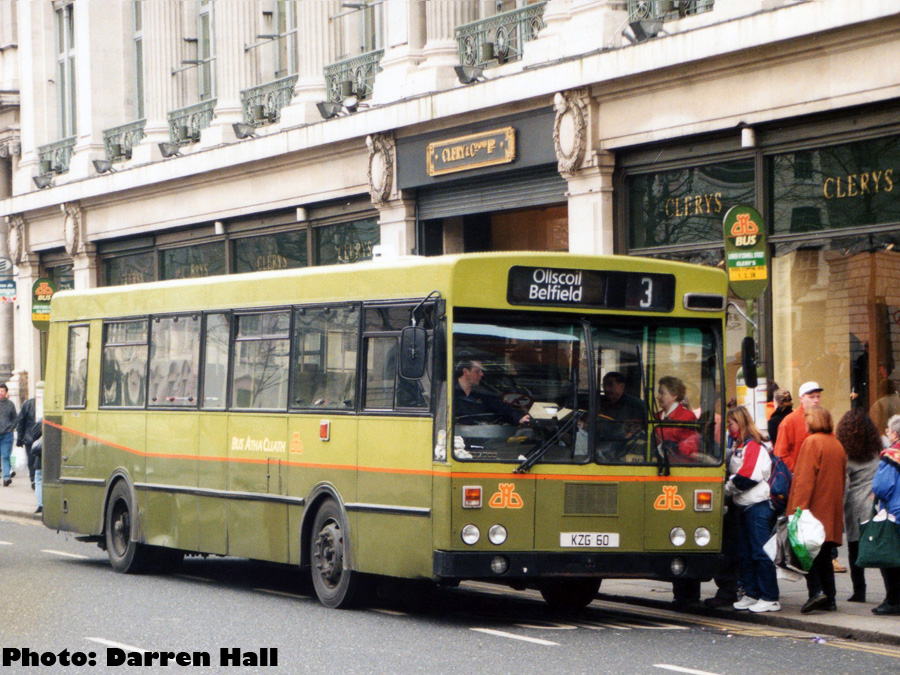
Donnybrook's GAC KC60 operating Route 3 to Belfield seen loading outside Clery's in O'Connell Street on the 28th January 1998 around 6 months before its withdrawal. The KC class were built like the KD double-deck buses in a factory in Shannon, outside Limerick City. This factory was operated by Bombardier and the General Automotive Company (GAC) building buses for CIE, who were displeased with the operation of the Leyland products bought during the late 60's and 70's. Prototype KC1 was built by FFG in Hamburg and had the same Detroit Diesel engine as the KD class. It was the only one to receive this engine as the rest of the class had Cummins L10 engines. KC2 was built by Bombardier/GAC, before Bombardier pulled out of the arrangment leaving General Automotive Company in complete control of the operations. Hence the KD class are ofter referred to as Bombardier and the KC class as GAC.
On the 2nd February 1986, the first DART feeder services began after an agreement was reached on OPO services. Route 52 which had previously been Townsend Street to Wilfield Road was completely reworked as a feeder service. In fact it did not share one part of its old routing with its new, operating from Sydney Parade Station to Kilmacud. This left the Wilfield Road area without a service, and Route 2 was therefore extended in order to cover this section, vacating its Sandymount Green terminus that it had shared with Route 18.
The new routing from Sandymount Road was Gilford Road, Sandymount Avenue, Willfield Park (terminate), Gilford park, Gilford Road, Sandymount Road to City. This was slightly different to Route 52 which had previously used both Willfield Road and Willfield Park, and Gilford Park in both directions. Route 2 may have terminated on Willfield Road, its timetable always said it did which was incorrect, but this could have only been for a very short period.
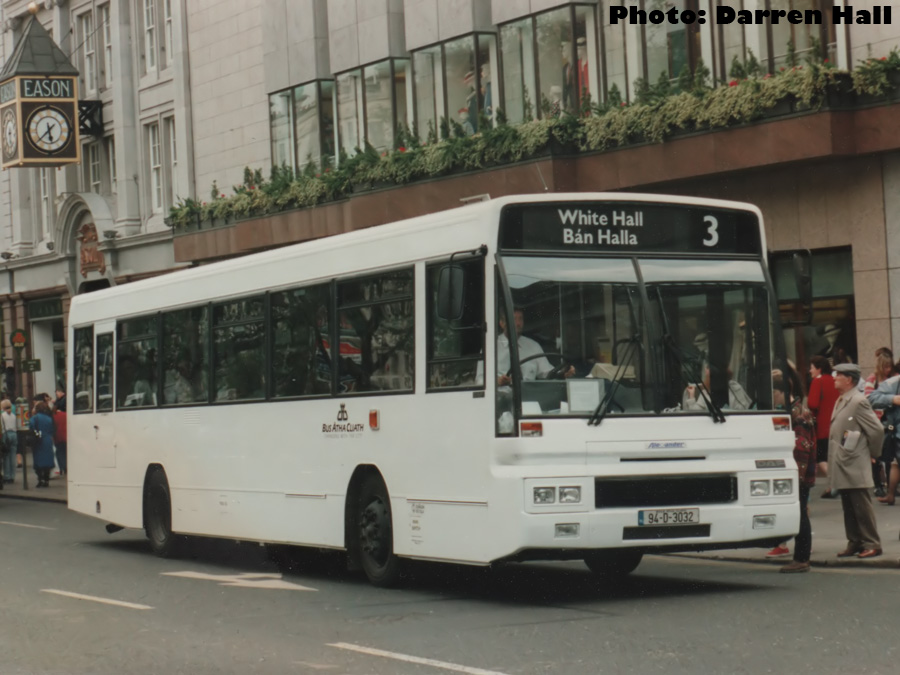
Alexander Setanta Bodied DAF SB220, AD32, seen on O'Connell Street operating a Route 3 service to Larkhill. Its destination shows White Hall (Irish Translation: Bán Halla), which is the district of Dublin in which Larkhill is contained. The destination also harks back to the days of the 3's original terminus at Whitehall Roundabout, in the same way that the Sandymount Tower scroll did for over 50 years after its move to St. John's Chuch. AD32 was one of a number of white AD-class buses delivered to Dublin Bus and was one of 3 to operate in plain white on Route 3. The rest of the white ADs went to Conyngham Road to operate Route 90 and would receive Stationlink livery around 1996.
With the launch of Dublin Bus in February 1987, there began a fast and rapid reorganisation of bus operations. This involved widespread OPO conversion and the removal of less profitable routes. High on this list were Routes 1 and 2. The 2 was finally withdrawn on the 5th November 1988.
Then from Monday 7th November 1988 (it only operated Monday-Friday) Route 1 was ammended to its current routing, thus avoiding Cambridge Road; serving Ringsend Road, Bridge Street, Irishtown Road, Church Avenue, Sean Moore Road, South Bank Road, Whitebank Road, Pigeon House Road. At this point Route 1 was reduced to its current very minimal service level.
On the 26th February 1990 selected journeys on the 3 were extended to Belfield via Sydney Parade Avenue, Ailesbury Road, Merrion Road, Nutley Lane, Stillorgan Road, Belfield Flyover, Belfield, thus providing a valuable link for those residing in the Ringsend and Sandymount areas with University College Dublin.
After the agreement on OPO services in 1986, most Dublin Bus routes had gone full capacity one person operated. There were some exceptions such as the 1, 2 and 3 and in July 1990 Dublin Bus and the Unions agreed that all remaining crew-operated routes could be operated by OPO drivers, with the remaining conductors seeing out their terms but not being replaced on retirement. Hence the 1, 2 and 3 continued to be crew-operated well into the 90s, not officially being noted as OPO routes until 1999.
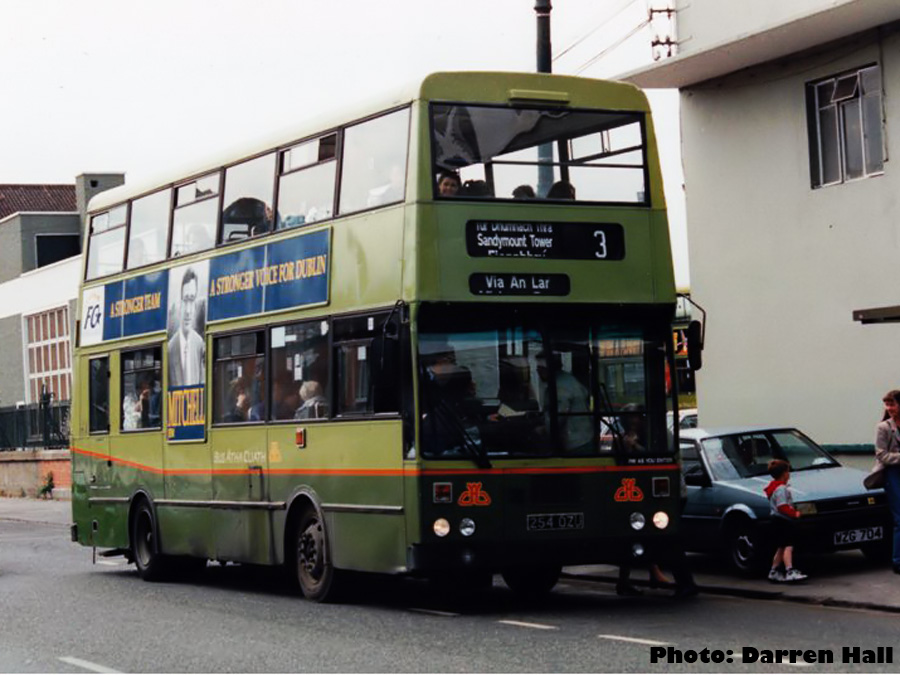
Ringsend's KD254 operates a Route 3 service to Sandymount on the 25th May 1994. It is seen here loading outside Ringsend Bus Garage on one of the very last days of Ringsend operation of the 3, before its return in 2006.
As part of the Tallaght Sector 4 changes that occurred end of May 1994, Routes 1 and 3 were moved from Ringsend to Donnybrook Garage. Initially they were operated by KDs, but Donnybrook then allocated Alexander-bodied DAF SB220s AD18, 21-5, 32-4, which were transferred from Phibsborough for the service, except AD23 which had been in Conyngham Road. Some at least entered service in Phibsborough, a picture of AD18 in full Cityswift livery, including branding, on the 40 taken by the late Eamon McArthur was contained in the July 1994 edition of Buses magazine. AD18, 21-25 entered service in Donnybrook in CitySwift livery without the branding, whilst AD32-4 were in overall white.
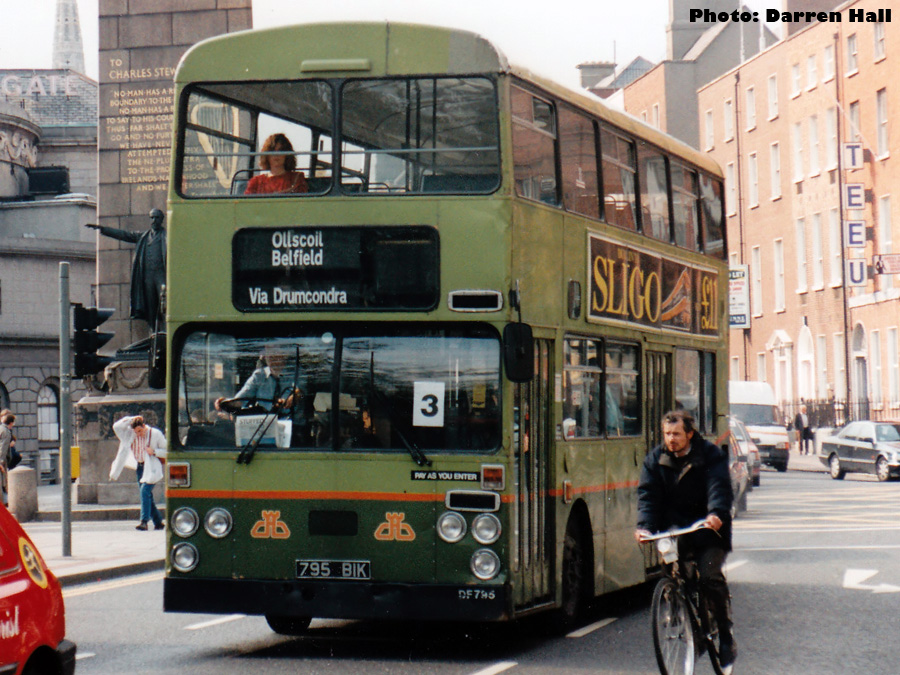
Donnybrook's DF795 operating a Route 3 service to Belfield on the 1st June 1994. Route 3 had just transferred to Donnybrook where it was originally assigned mostly KD-class double deckers prior to the transferral of the AD-class buses for this service. DF795 transferred from Conyngham Road as part of the Sector 5 major network revamp in February 1994, which saw the introduction of the 123 and the 78A Cityswift conversion. Being fitted with a Donnybrook scroll meant the bus couldn't display Route 3, instead a paper sheet in the window displaying 3 sufficed. DF795 was withdrawn from service soon after this photo was taken, being sent to the Driver Training School. It then went on to Bus Eireann in 1996 where it was converted into an open-topper for Sightseeing duties. It worked till the Summer 2005, then it went into storage in Capwell for many years after.
Dublin Bus received delivery of the VL class in late 1997, early 1998. The VL class were Alexander Ultra bodied Volvo B10L single-deckers. They featured a new innovation for Dublinbus in that they were the first buses to have kneeling suspensions. Dublin Bus bought five such buses VL1-5, while a sixth was acquired as part of an EU funded project in collaboration with Bord Gais. They were slightly longer than the AD class and therefore in December 1997 and January 1998 driver familiarisation was needed before this class entered service. VL1-4 were 1997 registered while VL5 and 6 were 2008 registered, VL6 only arriving in March. The VL class were the first buses delivered in the then new Dublin Bus blue and cream livery.
VL6 is interesting as it was CNG powered (compressed natural gas). The bus had a Volvo engine which was powered by CNG, the gas been stored in a tank on the roof of the bus. The gas was acquired from the Kinsale Gas field in Cork, and the buses refueled on a site in Sir John Rogerson's Quay. It carried an overall advertisement for Bord Gáis in sky blue colours, finally entering service on the 9th April 1998.
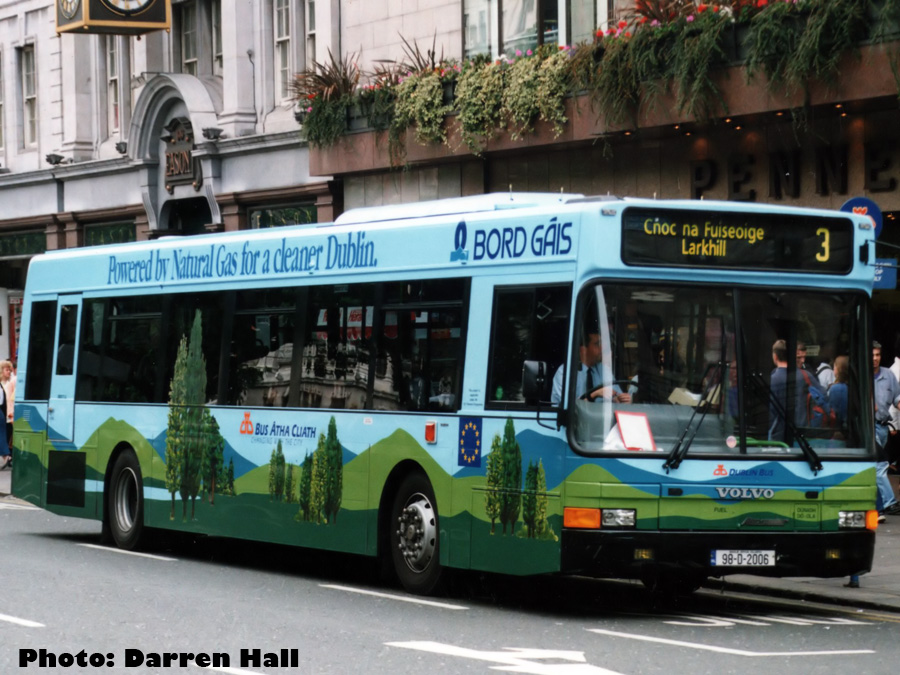
VL6 seen operating Route 3 to Larkhill on the 7th August 1998. It was given a sky-blue environmental advertisement and Bord Gáis and the European Union were noted on the bus, both being partners in the project. The bus did not prove to be a success, withdrawn circa April 2001, only 3 years after its introduction.
Route 3 was allocated these buses and was launched as the first "transport for all route", an advertisement accompanying the April 1998 timetable booklet. It was however not the first low floor bus route in Dublin, the 222 and 300 both operated by the W-class Mazda minibuses W1-5 being the first low floor routes. The VLs worked on the basis that the class was allocated to certain duty boards on Route 3, meaning certain journeys were operated by low floor and certain journeys with high floor AD class buses. Times where low floor buses operated were indicated in red, a new timetable being issued on the 22nd February 1998.
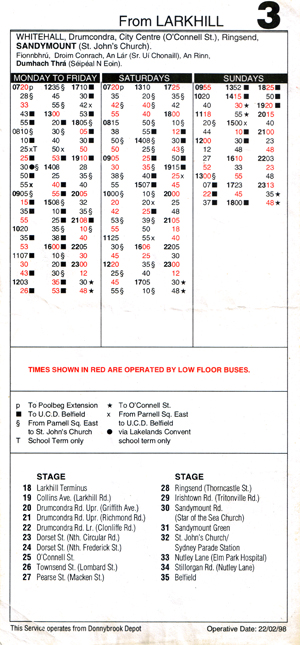
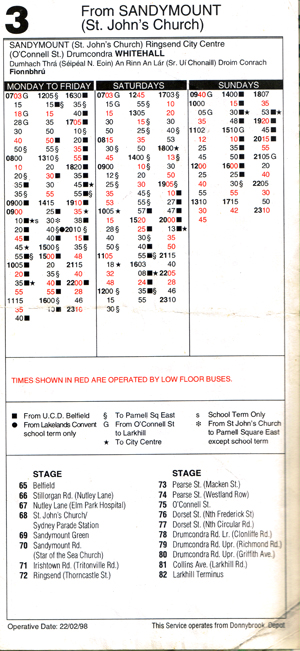
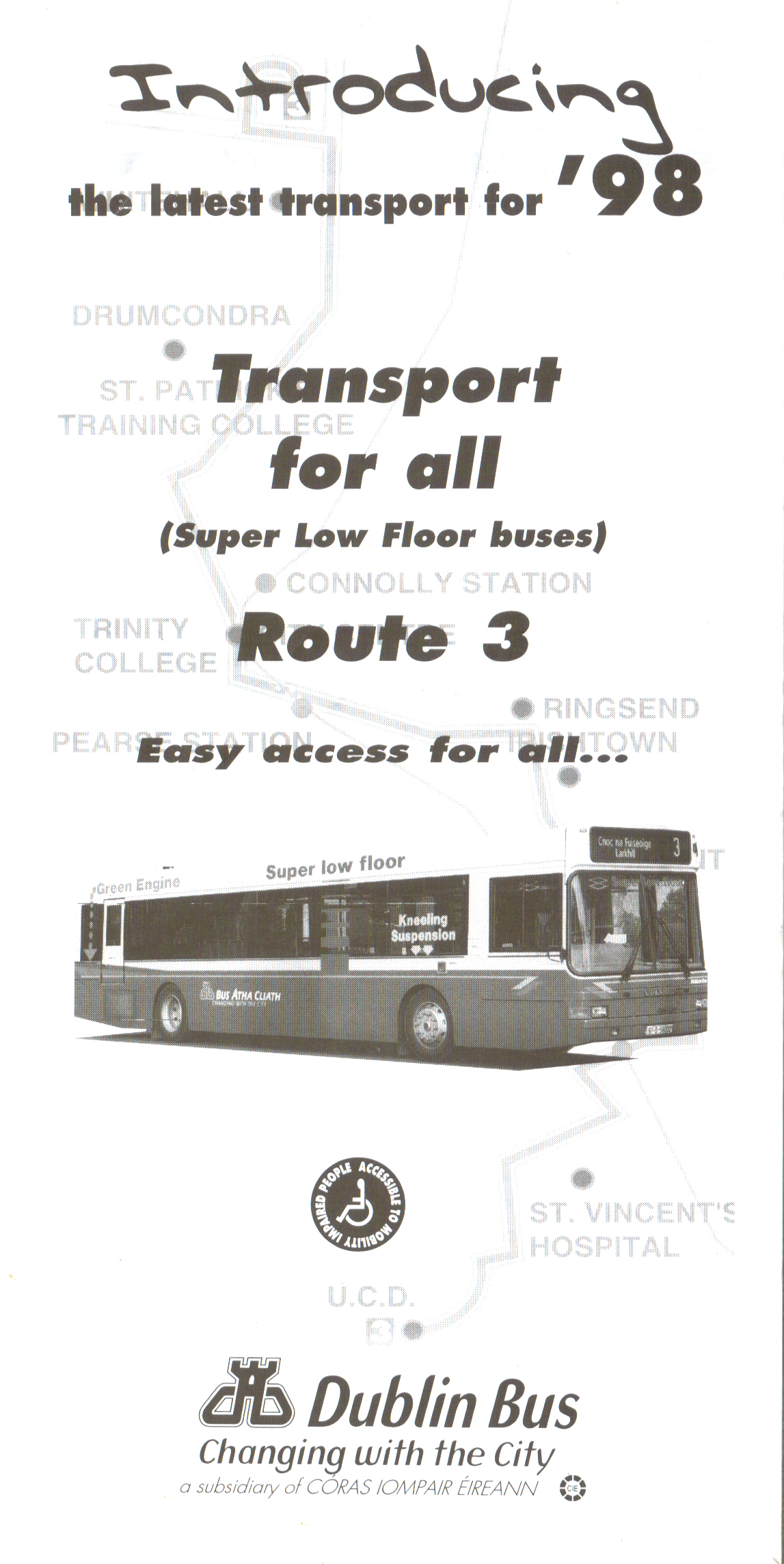
The delivery of the VL class was to correspond to a reorganisation of Route 3 which would have seen it extended to the Omni Shopping Centre in Santry. The VL class were delivered with Omni Centre on their scrolls but the ammendment never happened.
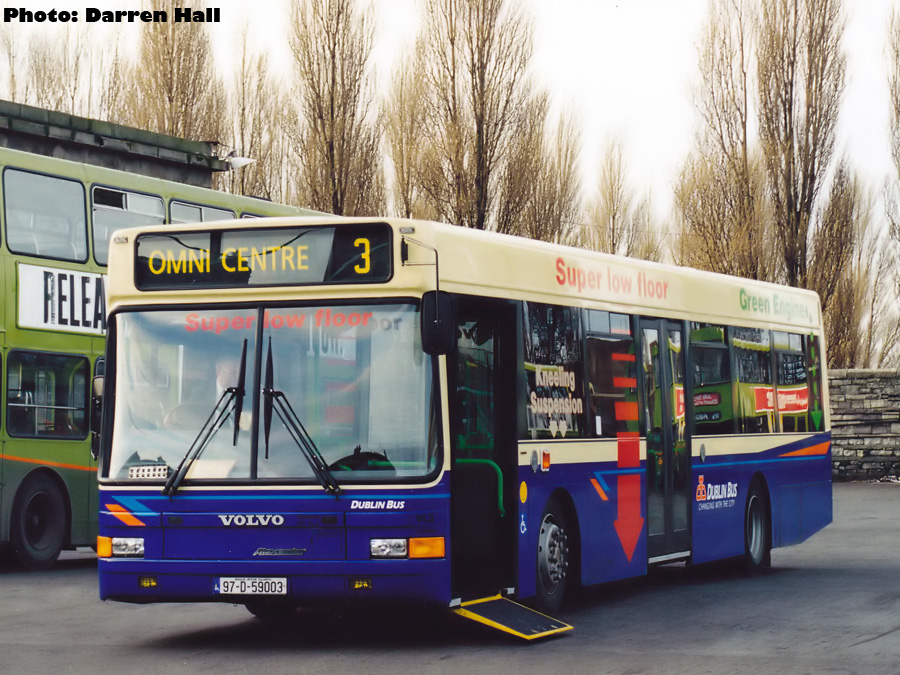
VL3 seen in the garage displaying both its wheelchair ramp and its scroll for the proposed new northside terminus of Omni Park. However the route change was never made.
On the 24th August 1998 Route 52 (St. John's Church - Kilmacud via Belfield) was discontinued. The 3 got a brand new timetable from this date which included a small number of shorts from St. John's Church to Belfield or Kilmacud in the peak periods, the services to Kilmacud being designated 3A. It was also from this point that the majority of services on Route 3 were cut short to operate only between Parnell Square and Sandymount/Belfield. Initially no mention is made to the designation of Route 2 for shorts to city only, however this appeared soon after in the timetables and may have been used very soon after the issue of the timetable in August 1998. These 3A services lasted until the 24th May 2009 when they were removed as part of a large number of cutbacks implemented due to the deteriorating finances of the company.
Routes 1,2 and 3 went fully low floor sometime in the second half of 2001/first half of 2002. The VLs suffered heavily from unreliability problems spending a lot of their time over Donnybrook garage's pits. They eventually drifted off to other routes such as the 59A in March 2002 and 111. The routes were then AV operated until the arrival of EV1-8 in 2007, Alexander Dennis Enviro400 bodied Volvo B9Ds, a new class to Dublinbus. These buses were delivered new to Ringsend Garage, these routes transferring back to Ringsend after 12 years in Donnybrook on the 10th December 2006, and strictly allocated to Routes 1,2 and 3. In fact their LED displays were limited so that they could not operate other routes in Ringsend depot.
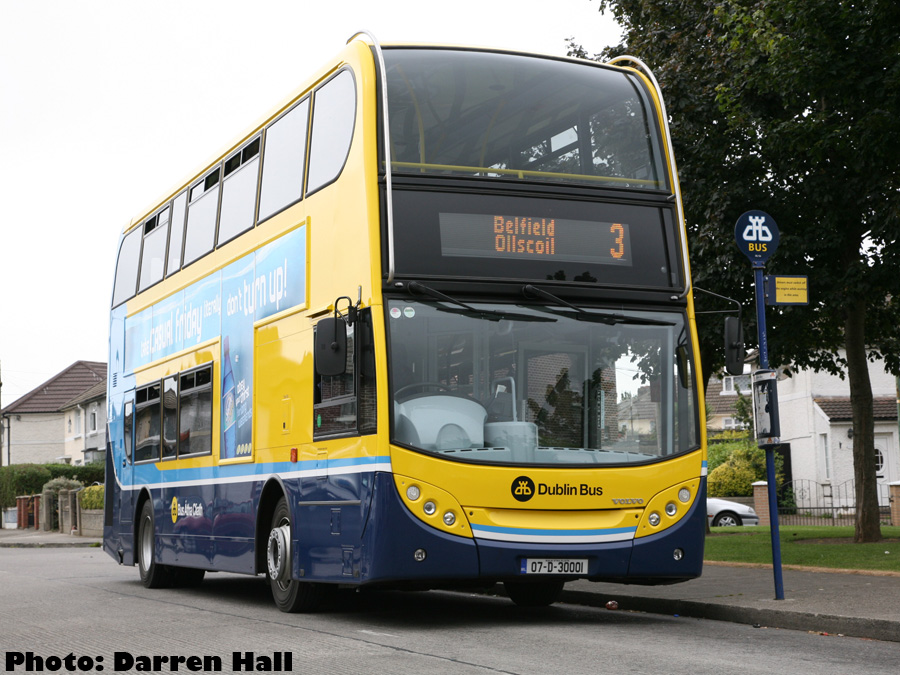
EV1, then only recently put into service in 2007, is seen at the Larkhill Terminus of Route 3 on Glendun Road, awaiting its time prior to operating a retun service to Belfield.
New Route 1 and the end of Routes 2 and 3
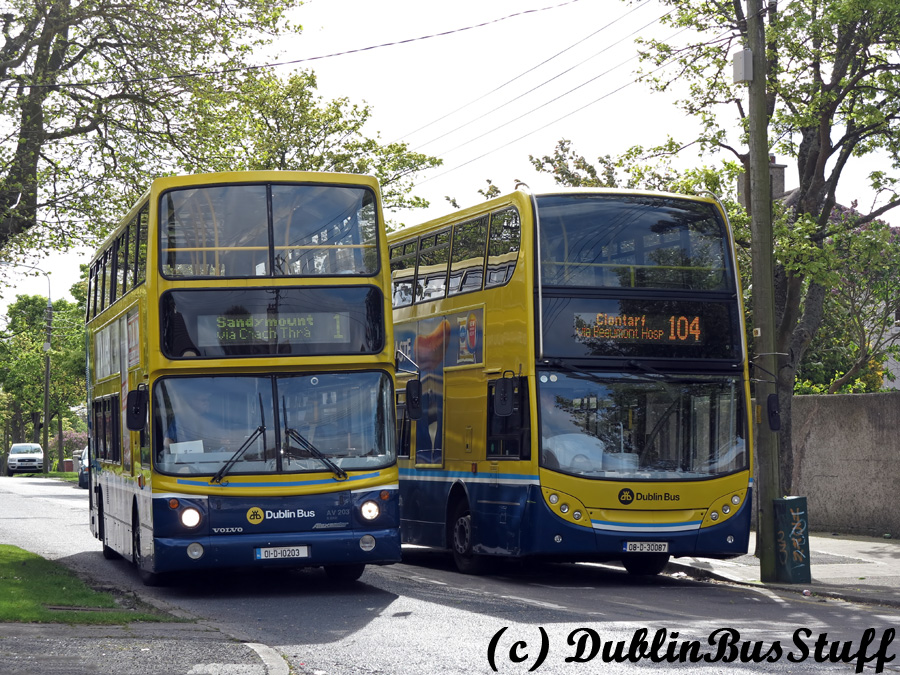
Ringsend's AV203 is seen operating the first ever Route 1 service from Santry, is seen passing out Clontarf's EV87 on Route 104, at their Shanard Road terminus on the 13th May 2012.
The Network Direct project, an ongoing Network redevelopment which is 20months through its implementation, has seen Routes 1,2 and 3, merged into a new Route 1, operating from Sandymount (St. John's Church) to Santry (Shanard Road (former Route16 terminus)). The new route started on Sunday the 13th May 2012. Daytime frequency is 20mins, with a 30min frequency on Sundays and at night.
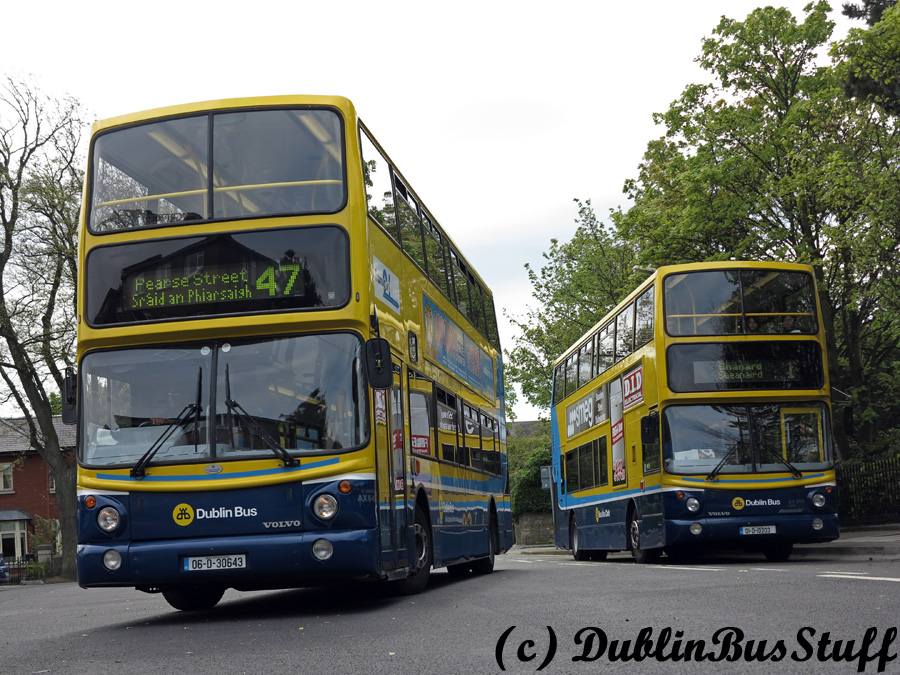
Donnybrook's AX643 is seen operating the newly aligned Route 47 is seen passing out AV213 at the St. John's Church terminus of Route 1 on the 13th May 2012.
Monday-Friday is confusing in that the first Route 1 service from Santry is not till 9am. Before this time, Route 16 operates from Santry on a 20min frequency. The new route provides a consistent frequency along the Sandymount corridor. The previous timetable left a lot to be desired. During the day Routes 2 and 3 were to give a 15min frequency combined, but the 3 left Larkhill 15mins before the 2 left Sandymount. The 3 was given 30mins to get into the city from Larkhill and would usually make Parnell Square in 15mins with the result that both buses operated in tandem. Thus, though providing a less number of departures, the new 1 service does provide a significant improvement for Ringsend/Sandymount customers. They also benefit from a newly rerouted Route 47.
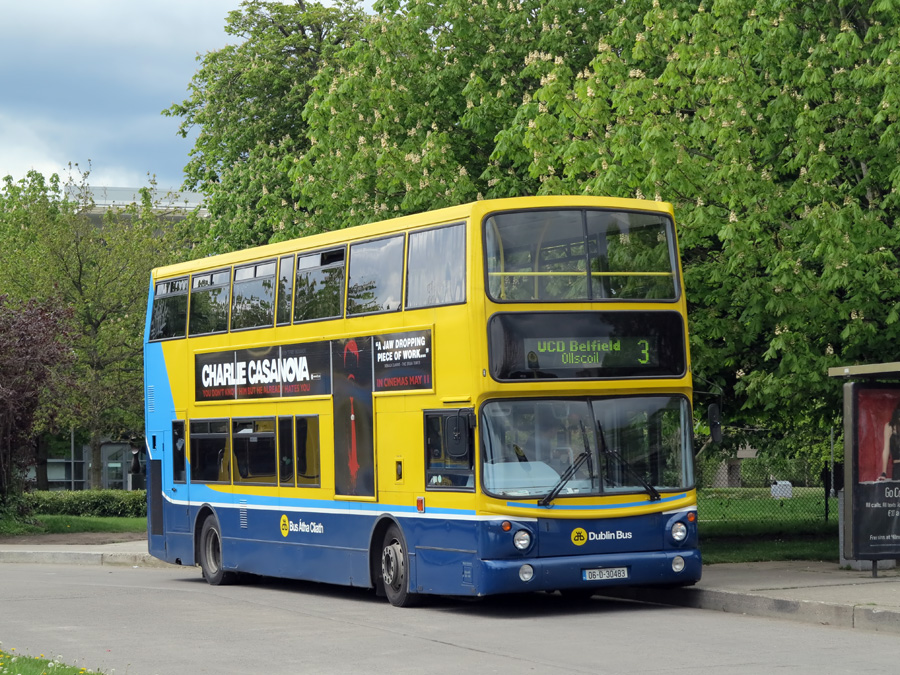
Ringsend's AX483 is seen at the UCD Belfield terminus of Route 3 on the last day of the route's operation, the 12th May 2012.
Saturday 12th May was the last day of operation of Routes 2 and 3. With the new Route 1 not linking Ringsend and Sandymount with Belfield, the loss of the 2 and 3 has meant the rerouting of Route 47. The 47 departs Fleet Street and follows Route 1 along the old alignment of Route 3 to the UCD Flyover. Instead of continuing onto the Belfield Campus, it instead continues as per the previous Route 47 routing to Belarmine.
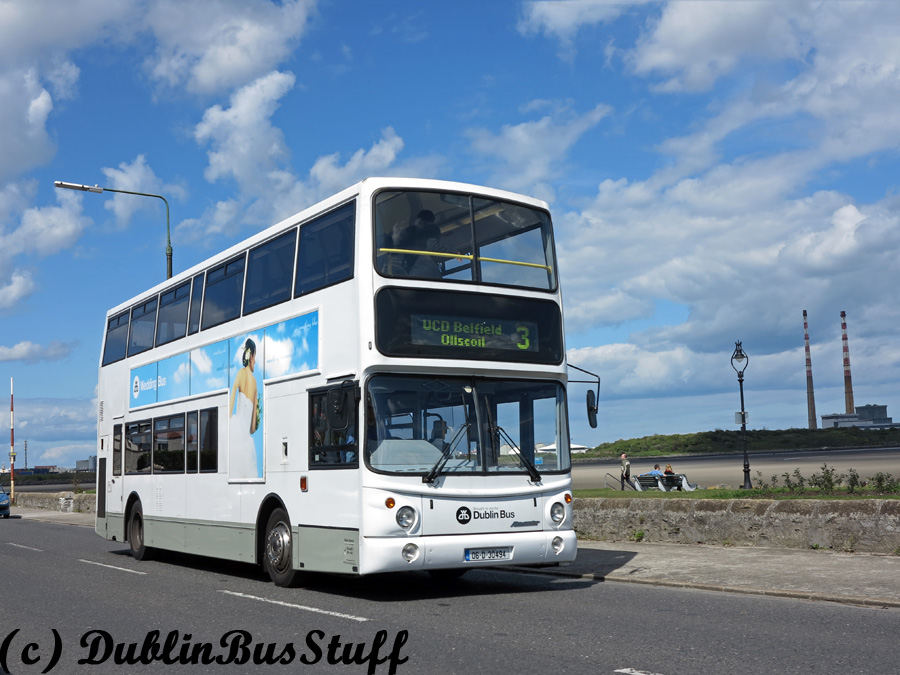
AX494 is seen on the Strand Road operating a Route 3 service to UCD Belfield on the 12th May 2012. The chimneys of the ESB's Poolbeg Power Station, served by the former Route 1 services, can be seen in the background.
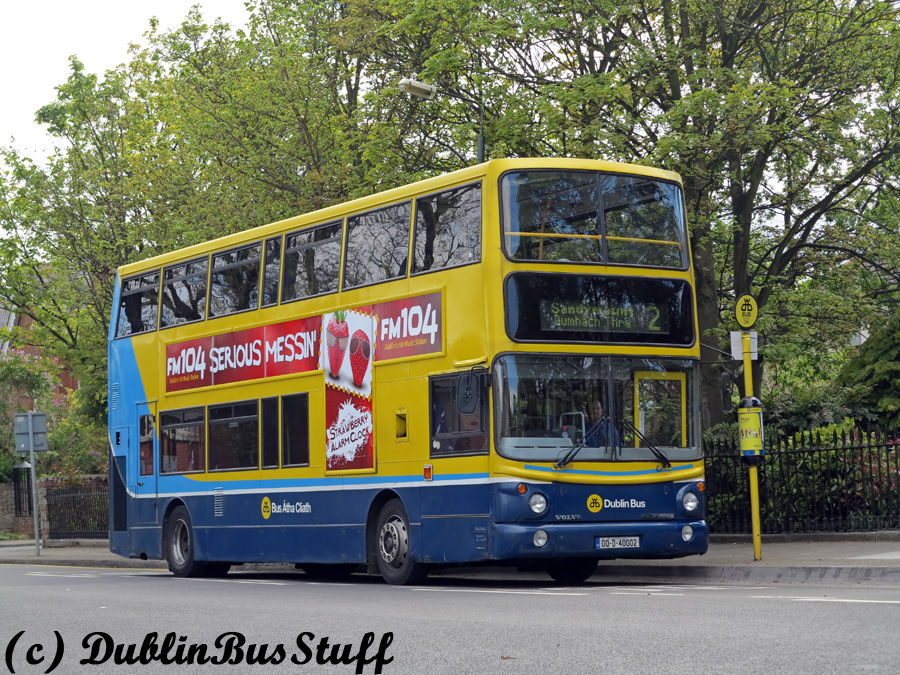
AV2 on the 2! Yes, the seldom found AV2 is seen here operating its number-sake Route 2 at St. John's Church on the 12th May 2012, the last day of this route's existence. Was it just coincidence that AV2 operated Route 2 on its last day, while AV3 spent a morning on Route 3, or was Ringsend fitting in its final day's allocation.
Route 3 has been replaced in Larkhill by an extended Route 44. The new Route 44 operates along the former Route 3's routing between Larkhill and Townsend Street before continuing as per its existing route to Enniskerry. Importantly, the diversionary loop into and out of Ballyogan in both directions is now avoided. Ballyogan has significantly benefited by a very high frequency Luas service linking it to Dundrum and the city. It also benefited in Round 1 of Network Direct back in September 2010, with a higher frequency Route 63 which was rerouted to serve the bustling town of Dun Laoghaire.
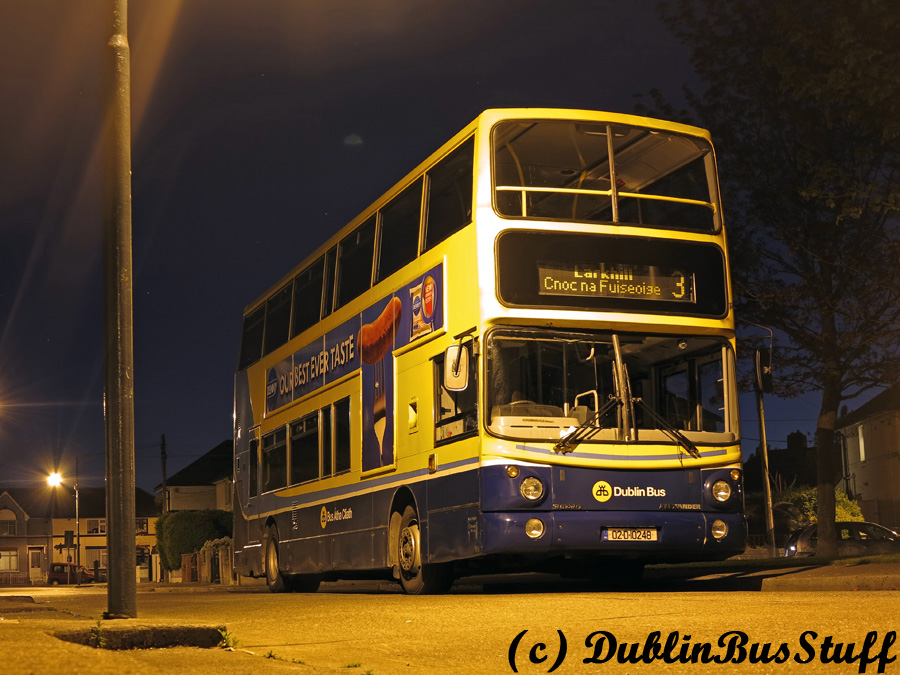
AV248 is seen at the Larkhill terminus of Route 3 about the operate the last 3 from there to Sandymount on the 12th May 2012.
Pigeon House Road is now without a service, after 61 years of continuous operation by the previous version of Route 1. AX483 is seen below on the last service there. It was officially a 2 to Sandymount via Poolbeg, however it was common for these services to display 1 due to distinguish their very special diversion. The bus actually entered the ESB grounds to turn about, a locally known arrangement as the former terminus has been inaccessible for a number of years due to a low height barrier placed further along the Pigeon House Road designed to keep certain folk out.
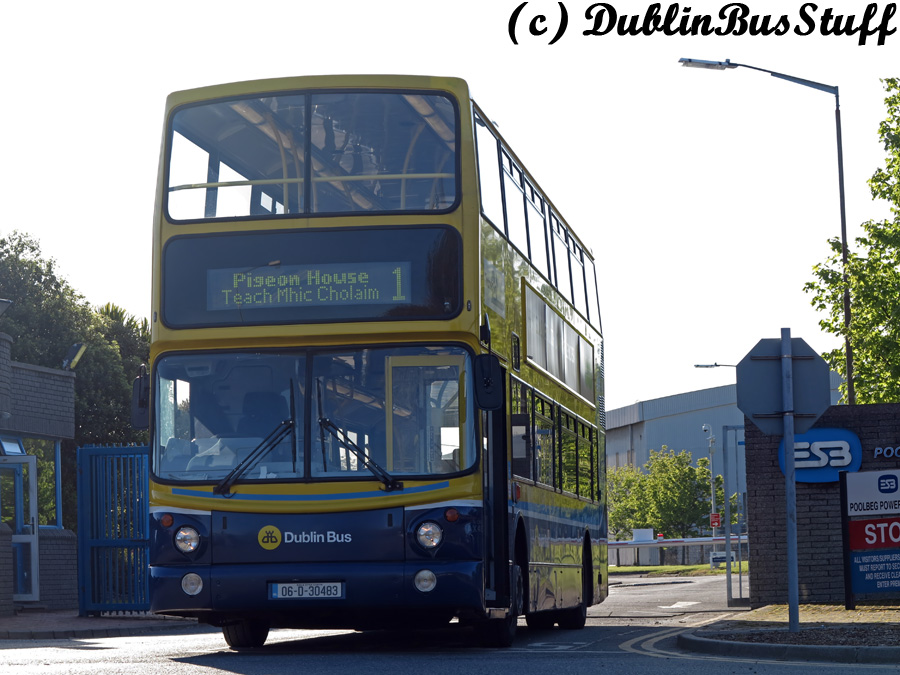
Ringsend's AX483 is seen on the last ever service to the Pigeon House on the 12th May 2012.
